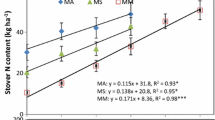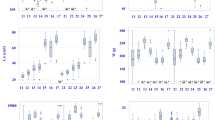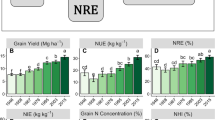Abstract
An earlier study revealed considerable genotypic variation in grain N, P and K concentrations (GNC, GPC and GKC, respectively) in tropical maize. The expression of varietal differences in GNC, GPC and GKC, however, may depend on environmental conditions such as the N status of the soil. Two tropical maize hybrids (Suwan 2301 and CP 1) with comparable yielding capacity, but contrasting GNCs, GPCs and GKCs, were therefore grown at four levels of N in a field experiment at Farm Suwan (Thailand, latitude 14.5°N). Suwan 2301 exhibited a higher GNC than did CP 1 at all rates of N, but large differences in GPC and GKC were found only at high N fertilization. This was obviously due to individual grain yield responses of the cultivars to increasing rates of N fertilizer, demonstrating that grain nutrient concentrations are, at least in part, functions of the amount of grain carbohydrates which dilute a genetically and environmentally fixed amount of grain P and K. As compared to Suwan 2301, CP 1 accumulated less N, P and K in the grains at almost all levels of N fertilization, confirming our hypothesis that the cultivation of maize genotypes with low grain mineral nutrient concentrations may help third-world cash-crop farmers to reduce the need for scarce and costly mineral fertilizers. This finding has to be verified at reduced availability of soil −P, −K, and water.
Similar content being viewed by others
References
Alexander D E 1988 Breeding special nutritional and industrial types. In Corn and Corn Improvement. Ed. G F Sprague. pp 869–880. Agronomy Monograph no. 18, 3rd edition. ASA-CSSA-SSSA.
Castleberry R M, Crum C W and Crull C F 1984 Genetic improvement of U.S. maize cultivars under varying fertility and climatic environments. Crop Sci. 24, 33–36.
Dudley J W, Lambert R J and de laRoche I A 1977 Genetic analysis of crosses among corn strains divergently selected for percent oil and protein. Crop Sci. 17, 111–117.
Eberhard D 1977 Untersuchungen über den Einfluß von proteinreichen Inzuchtlinien auf die Ertragsgestaltung von Hybriden unter dem Aspekt der Körner- und Silonutzung von Mais (Zea mays L.). Ph.D. Thesis, Hohenheim, Germany.
Feil B, Thiraporn R, Geisler G and Stamp P 1990 Genotype variation in grain nutrient concentration in tropical maize grown during a rainy and a dry season. Agronomy 10, 717–725.
Forbes R M, Parker H M and ErdmanJr J W 1984 Effect of dietary phytate, calcium and magnesium levels on zinc bioavailability to rates. J. Nutr. 114, 1421–1425.
Frey K J 1977 Protein of oats. Z. Pflanzenzüchtg. 78, 185–215.
Gardner C A C, Bax P L, Bailey D J, Cavalieri A J, Clausen C R, Luce G A, Meece J M, Murphy P A, Piper T E Segebart R L, Smith O S, Tiffany C W, Trimble M W and Wilson B N 1990 Response of corn hybrids to nitrogen fertilizer. J. Prod. Agric. 3, 39–43.
Gupta D, Kovacs I and Gaspar L 1975 protein quality traits and their relationships with yield and yield components of opaque-2 and analogous normal hybrids and inbred lines. Theor. Appl. Genet. 45, 341–348.
Hambidge K M and Walravens P A 1976 Zinc deficiency in infants and preadolescent children. In Trace Elements in Human Health and Disease. Eds. A S Prasas and D Overleas. Vol. 1, Chapter 2, pp 21–32. Academic Press, New York.
Heitholt J J, Croy L I, Maness N O and Nguyen H T 1990 Nitrogen partitioning in genotypes of winter wheat differing in grain N concentration. Field Crops Res. 23, 133–144.
Kauffman K D and Dudley J W 1979 Selection indices for grain yield, percent protein, and kernel weight. Crop Sci. 19, 583–588.
Michael B, Zink F and Lantzsch H J 1980 Effect of phosphate application on phytin-phosphorus and other phosphate fractions in developing wheat grains. Z. Pflanzenernaehr. Bodenkd. 143, 377–384.
Muruli B I and Paulsen G M 1981 Improvement of nitrogen use efficiency and its relationship to other traits in maize. Maydica 26, 63–73.
Raboy V, Dickinson D B and Neffer M G 1990 A survey of maize kernel mutants for variation inphytic acid. Maydica 35, 383–390.
Thiraporn R, Geisler G and Stamp P 1987 Effects of nitrogen fertilization on yield and yield components of tropical maize cultivars. Z. Acker Pflanzenbau 159, 9–14.
Tsai C Y, Huber D M, Glover D V and Warren H L 1984 Relationship of N deposition to grain yield and N response of three maize hybrids. Crop Sci. 24, 277–281.
Author information
Authors and Affiliations
Rights and permissions
About this article
Cite this article
Feil, B., Thiraporn, R. & Stamp, P. Can maize cultivars with low mineral nutrient concentrations in the grains help to reduce the need for fertilizers in third world countries?. Plant Soil 146, 227–231 (1992). https://doi.org/10.1007/BF00012016
Issue Date:
DOI: https://doi.org/10.1007/BF00012016




